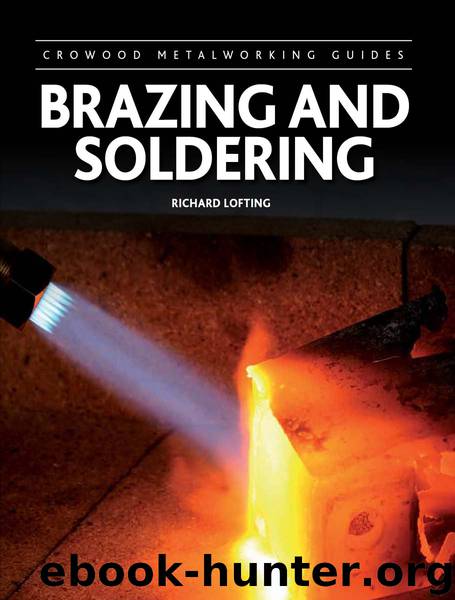Brazing and Soldering by Richard Lofting

Author:Richard Lofting
Language: eng
Format: epub
Publisher: Crowood
After the first high-temperature brazing operation to repair a fuel tank take-off pipe, everything was cleaned before setting up for the second step.
The lower-temperature second joint was completed without melting the first joint.
MATERIAL SELECTION
While the material selection for whatever project you envisage is beyond the remit of this book, certain criteria and pitfalls are worth mentioning here, as they could lead to catastrophic circumstances if the wrong selection is made. For example, when building a boiler from copper for a model steam engine, it is imperative that the right grade of copper is used. What is known as oxygen-free copper will be required – either C103 or C106 grade of phosphorous deoxidized copper should be selected. Copper that is known as tough pitch, high-conductivity or electrolytic C101 copper will contain oxygen. On heating, this can produce steam, which breaks down and causes hydrogen embrittlement within the material’s structure; it is this that will cause the structure failure. Also, with safety-critical work, careful selection of the filler rods will be vital, checking that there are not any metals present in the chosen rods, such as aluminum or titanium, that could alloy with the copper, forming an intermetallic compound and leading to possible joint failure at some time in the future.
ALUMINIUM BRAZING
Aluminium brazing is seen by some to be a mystical art best left alone, but it is in fact similar to any other brazing operation. The main difficulty is that aluminium and its alloys melt at relatively low temperatures and show no signs that they are about to melt, as other metals do by going red hot beforehand. The other problem associated with aluminium alloys is that they have a very tough oxide layer on the surface. This is what makes these alloys suitable for many applications, as once this oxide skin has formed very little further corrosion takes place. As we now know, it is the oxides that need to be removed before a successful soldering or brazing operation can take place. Pure aluminium melts at 660°C and its various alloys between 640°C and 655°C, whereas aluminium oxide does not melt until it reaches temperatures in excess of 2,000°C, although it does weaken somewhat at around 300°C. Either mechanical or chemical means will be required to cut through the oxide layer; due to its tenacity, very acid fluxes are required.
Download
This site does not store any files on its server. We only index and link to content provided by other sites. Please contact the content providers to delete copyright contents if any and email us, we'll remove relevant links or contents immediately.
On Writing A Memoir of the Craft by Stephen King(4651)
The Doodle Revolution by Sunni Brown(4493)
A Simplified Life by Emily Ley(3959)
Mummy Knew by Lisa James(3511)
Marijuana Grower's Handbook by Ed Rosenthal(3507)
Better Homes and Gardens New Cookbook by Better Homes & Gardens(3360)
Paper Parties by Erin Hung(3305)
Figure Drawing for Artists by Steve Huston(3266)
Draw Your Day by Samantha Dion Baker(3116)
The Genius of Japanese Carpentry by Azby Brown(3029)
Japanese Design by Patricia J. Graham(2992)
The Code Book by Simon Singh(2846)
Lions and Lace by Meagan Mckinney(2840)
Dangerous Girls by Haas Abigail(2834)
The Curated Closet by Anuschka Rees(2793)
How to Make Your Own Soap by Sally Hornsey(2736)
The Checklist Manifesto by Atul Gawande(2648)
The Wardrobe Wakeup by Lois Joy Johnson(2629)
Zero to Make by David Lang(2616)
